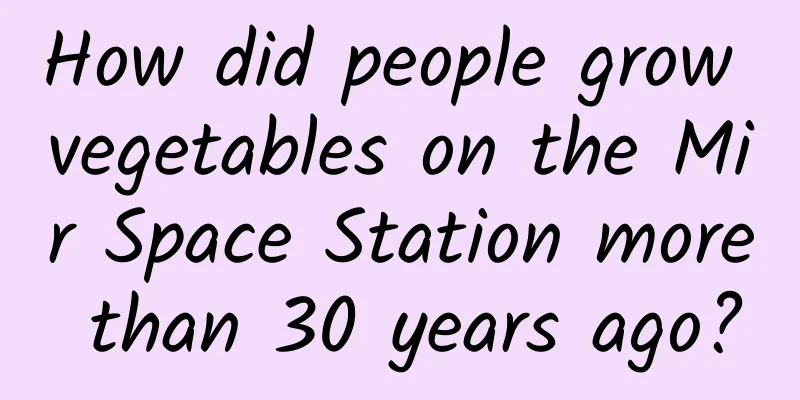How did people grow vegetables on the Mir Space Station more than 30 years ago?

|
The designer of the world's first fully functional space plant cultivation facility was not from the United States, the Soviet Union or Russia, nor from developed Western European countries or Japan, but from the small Eastern European country of Bulgaria. From 1983 to 1991, the Soviet Union and Bulgaria cooperated in the framework of the "Interstellar" program to develop SVET equipment. What does the SVET Space Greenhouse look like? The SVET Space greenhouse has 1000 square centimeters of growing area and can accommodate 40 mature plants. The plant room is illuminated by fluorescent lamps and has two wide windows (the front window is transparent) for workers to sow seeds, observe and take samples. The root module is divided into two equal parts and filled with a natural zeolite rich in mineral salts to sustain several consecutive crop cycles. This is an original Bulgarian technology. This module is replaceable and mounted on rails, like drawers. The substrate moisture is precisely controlled at the ideal level by sensors, valves and water pumps, and the necessary oxygen is supplied to the root zone. SVET's appearance The controller collects environmental data from the sprout and root zones and uses lights, ventilators, pumps and compressors for automatic control. On June 16, 1990, Soviet cosmonauts Alexander Barand and Anatoly Solovyov conducted the first 54-day long-term plant experiment on white-topped red radishes and Chinese cabbages, called "Greenhouse 1". Composition of SVET When fresh plant samples were returned to Earth for investigation, they developed well, marking the first time that humans had grown radish root crops under microgravity conditions, but their volume was only one-third of the control group on the ground. The biomass of plants grown in space and under Earth conditions differed greatly (4 to 8 times), indicating that space plants suffered from severe water and nutrient deficiencies, and the balance between the optimal air and water content in the plant root medium was disturbed. Plants growing in SVET In any case, the first experiment was an indisputable success, proving the efficiency of Bulgarian space research equipment and biotechnology. But the end of the experiment coincided with the collapse of the Soviet Union, and subsequent experiments were suspended for five years. First seed-to-seed experiment in space NASA's interest in the Mir space station saved SVET. In 1993, US Vice President Al Gore and Russian Prime Minister Viktor Chernomyrdin signed an agreement to conduct joint space research using the hardware facilities available on Mir. In April 1994, the United States, Russia and Bulgaria signed an agreement in Moscow to conduct long-term experiments with SVET on Mir from 1995 to 1997. The basic biological mission was to achieve the complete wheat seed-to-seed life cycle with the participation of US astronauts, with equipment and samples delivered by multiple space shuttle and Russian cargo missions. Bulgaria continued to be responsible for the development of the second-generation improved SVET-2 space greenhouse. SVET system on the Mir space station The cooperative flight of the Mir Space Station and the US Space Shuttle has enabled the STVE experiment to be carried out for a long time. Under the agreement, the Space Dynamics Laboratory at Utah State University developed the U.S. Gas Exchange Measurement System (GEMS) for enhanced environmental monitoring. GEMS was added to the SVET space greenhouse in orbit in 1995. The new SVET-2 places two separate transparent bags above the plants, one bag on each of the root module sections that enclose the plant chamber volume, to allow for local gas exchange and leaf environmental measurements. GEMS provides four infrared high-precision gas analyzers that measure the absolute carbon dioxide and water vapor levels and their differences in the air entering and leaving each bag, as well as the absolute and differential pressures of the measured gases. These are necessary to assess photosynthesis, respiration and transpiration of the plants. The cabin pressure and oxygen levels are also measured. All environmental data are collected on a disk using a laptop and brought to Earth at the end of the mission. The SVET system has one substrate moisture sensor per root module section, which is sufficient to measure and control substrate moisture levels. The GEMS also comes with 16 substrate moisture sensors (8 per module) to monitor moisture distribution throughout the substrate volume. A series of long-term plant experiments were conducted in the SVET-GEMS complex from 1995 to 1997. In 1995, the first attempt to grow super-dwarf wheat in the complex was made as part of the Mir Space Station-Space Shuttle Program. During the 90-day experiment, the low light intensity in Greenhouse 2a and other technical problems seriously disturbed the genetic cycle of the wheat plants. In 1996, Bulgarian scientists developed a new, improved device, which was launched on Mir. The new lighting unit had a light intensity 2.5 times higher, and all other units worked well. Astronaut Lucid observes the growth of wheat in SVET The super dwarf wheat experiment "Greenhouse 2b" was repeated in 1996 in the new SVET-2-GEMS complex. The Greenhouse 2b experiment was conducted in two phases of 123 days and 42 days. In the first phase, the goal was to grow wheat in the complete seed-to-seed life cycle. Although 297 perfect-looking wheat ears developed in the growing area, all of them were sterile, with development arrested at the pollen development stage. Ground studies have proven that 1-2 ppm of ethylene in the Mir cabin air can induce male sterility in wheat plants. In the second test phase, new wheat seeds were planted, leaf bags were installed, and transpiration and photosynthesis measurements were successfully carried out for the first time using the GEMS equipment over a period of 12 days. GEMS proved that open-air gas exchange measurements can be made in space. The green plants were frozen and returned to Earth for biochemical analysis. In 1997, the "Greenhouse 3" seed sowing experiment was carried out on the SVET-2-GEMS equipment, using a mustard plant with a very short life cycle, Brassica napus. On June 25, 1997, the collision between the Mir and Progress supply spacecraft caused the SVET-2 space greenhouse to lose power, lower the temperature, and change the atmospheric pressure and composition. American astronaut Michael Fowler transferred the power from the core module to SVET through wires, saving the experiment and ensuring the success of the first seed-to-seed full growth cycle in space. The first space seed (produced in space) was sown and germinated again, and a normal plant was cultivated. Mir Space Station Planting wheat in the sky The scientists are trying to plant wheat seeds. Bruce Bagby, a scientist at Utah State University, suggested using another wheat variety, Apogee, because it can withstand high ethylene concentrations. Experiments with wheat plants continued in 1998-1999. The "Greenhouse 4" and "Greenhouse 5" experiments were conducted by Russian cosmonauts. In the "Greenhouse 4" experiment, 12 "Apogees" produced a total of 508 seeds. Dry matter samples were collected and most of the seeds were returned to Earth. In the Greenhouse 5 experiment, 10 space-produced seeds were planted, one of which produced a second generation of space seeds. All seeds produced during these two experiments were normal. They germinated after being planted on Earth and grew into healthy green plants. The last experiment of SVET-2 "Greenhouse 6" was carried out in May-June 2000. Seeds of four different varieties of lettuce crops (Brassica rapa) were planted by the last crew of the Mir space station and grew normally. These plants were selected because of their short vegetation period. Samples of each plant were brought back to Earth. And the rest were tasted with pleasure by cosmonauts Sergey Zaliotin and Alexander Kaleri to evaluate the flavor quality of plant products. Astronauts Sergey Zaliotin (left) and Alexander Callery |
<<: Where did the Kuahuqiao people, the surfers of Qiantang River 8,000 years ago, go?
>>: It’s heavy and rotates slowly, so what are the advantages of a building’s revolving door?
Recommend
The booster behind the location-based security smart hardware
If you have seen the movie "Dear", you ...
How to quickly increase followers on Xiaohongshu?
Today I want to talk about a hot topic, as the ti...
Create China's treasure island with the roar of mountains and seas!
Taiwan A land that touches the emotions of all Ch...
Why didn't the dinosaurs, which ruled the earth for more than 100 million years, add skill points to wisdom?
Review expert: Zhu Guangsi, member of Beijing Sci...
How to seize new opportunities in the workplace? Fangcunshan will help you make 72 changes in your career
How to seize new opportunities in the workplace? ...
Why do cats and tigers look so similar?
Regarding cats and tigers, many people have proba...
Product Operation: SOP Process Building Methodology!
For operators, SOP capability is a basic capabili...
How long can the huge profits of auto finance last?
If selling cars is not profitable, what will the ...
How to increase the volume of Baidu bidding account promotion?
Just now, friends in the group were discussing th...
The 10 hottest growth strategies of 2019
There are two obvious trends in 2019: as the traf...
Grasshopper "daughter kingdom": only females, can give birth to offspring, and live well | Nature Trumpet
Welcome to the 10th issue of the Nature Trumpet c...
Event promotion method: 4 steps to design an event to attract new customers using old customers!
Nowadays, it is becoming more and more expensive ...
How to apply the 80/20 rule in designing self-propagation and new sharing activities?
If you want to enhance the self-propagation abili...
The three levels of OTA operations: basic rules, traffic thinking, and brand thinking
OTA operation is a very complex and all-encompass...









